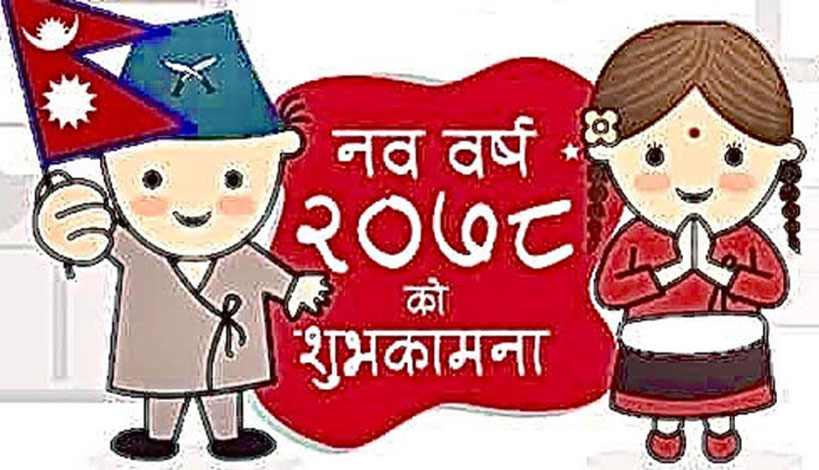HAPPY NEWS YEAR 2078 BS
Among the many festivals, the first day of Baisakha is also important not only because of the New Year’s Day but also has its own value from the cultural viewpoint.
New Year means a refreshing and rejoicing mood! This day gives inspiration to all to start work anew with newer resolutions and also by reaffirming good intentions on our march towards development and prosperity.
Nepal is celebrating the New Year today– Wednesday 14th of April, 2021 marking the beginning of Nepali Era Bikram Sambat 2078.
Besides Nepal, India, Pakistan, Bangladesh, Myanmar, Sri Lanka, Thailand, Laos, Cambodia and Indonesia are also entered towards their New Year Day on Wednesday.
The New Year is celebrated, rejoiced or in quietly but will be observed in colourfully. The New Year celebrations are simple in the Nepalese home: family priests visit their patrons’ houses and give them predictions for the coming year from Sanskrit astrological almanacs.

Nepal’s every festival is rooted in the country’s history, mythology and religion, honour and propitiate the multitude of gods, controls malicious spirits, or celebrate mythological victories over evil.
Mes means Aries (Ram). In Sanskrit, it means the first day of the month. Mes Sankranti, therefore, means the day when the Sun enters Aries in the Zodiac system.
On this day all the Nepalese exchange greetings wishing each other a Happy New Year. This day is notable not only as New Year’s Day but also as a day of festivity and of religious sanctity.
Early in the morning of this day religious-minded Kathmandutites especially go to Tokha, six miles north of Kathmandu to bathe in a stream known as “Swapna Teertha”, popular called “Sapan Teertha”. There is a legend behind the name “Swapna Teertha”.
“Swapna Teertha” literally means the stream of a dream. The legend goes on to say that once there lived a leper in a hut near Swapna Teertha. The leper had even lost his fingers and toes. His wife would go on begging for alms for her husband. One night the leper dreamt a dream in which he was advised to bathe in the holy stream flowing nearby on Mes Sankranti for the recovery from his leprosy.
But the leper had forgotten all about his dream and on Mes Sankranti his wife went to beg alms early in the morning with a view to getting more on that day. The day it so happened that a grasshopper settled on the body of one of the cowherds who were grazing their cows in the meadow in front of the leper’s hut. The cowherd, while trying to remove it with his hand, dismembered the insect’s leg by chance and he threw it into the stream flowing front of the hut of the leper. But to his surprise and to the surprise of all other cowherds the grasshopper hopped out of water with its leg fully restored.
This aroused their curiosity and other cowherds also catching hold of other grasshoppers broke their legs and threw them into the same stream. To their surprise they all hopped out of water with their legs fully restored. This sport of the cowherds reminded the leper of his dream and he at once came out of his hut and bathed in the stream and his lost fingers and toes were also restored.
When his wife came back, the show could not recognize her husband who had in a way undergone a complete change in form. She refused to acknowledge him as her husband until this case was reported to the then king. The king and his consort came there with a lame man to test the veracity of the report. When the lame man bathed there, his lameness was gone and only then the wife of the leper acknowledged him as her husband. Ever since the stream has been known as Swapna Teertha of Sapan Teertha.
On the same day in Bhaktapur, the New Year coincides with Bisket Jatra, one of the most exciting of all major festivals of the Valley. In the street of Bhaktapur, however, it’s a noisy and crowded celebration of the God Bhairav and his wife Bhadrakali; and the celebration of victory over two evil serpent demons.
Biska Jatra is an annual event in Bhaktapur. The festival is celebrated at the start of the new year on the Bikram Sambat calendar,

The word Bisket comes from the Newari language word Bi Syako. Bi means snake and Syako means slaughter. With the tongue slip while pronouncing Bisyako becomes Bisket later, which is a celebration to commemorate the death of two (male and female i.e.: tantric and his wife) serpent demons- come into existence.
During the festival days, people make the rounds of all the temples of the town with offerings, for it is thought that the gods and goddesses all come to visit Bhakatapur at Bisket Jatra.
On the last day of the old year a great ceremonial pole is erected in an open area on the banks of Hanumantte River near the downtown Bhaktapur. From a cross beam two long banners hang to the ground, representing two vanquished snake demons.
Thousands of inhabitants and the people from Kathmandu and Patan and surrounding hills also go to Bhaktapur to see the pole raised. Tense silence breaks into cheers and shouts when the pole is up, flying its two snake banners. Courageously youths swarm up the ropes to grab the flowers and leaves affixed to the top of the pole, a token of luck for the year ahead.
On New Year Day people crowding into the field around the pole to witness the ceremonial pulling down of the pole. Teams of men have another tug-of-war, pulling the pole this way and that, creating thrills and excitement amongst the people. After several swings and jostles, the huge pole finally crashes to the ground, and only then according to the people of Bhaktapur, the New Year actually commences. The old year is dead and so are the evil snake demons.
Festivities are also going on in the little town Thimi-on the way to Bhaktapur. New Year in Thimi is a celebration of their guardian Bal Kumari, another consort of Bhairav.
Every festival in Nepal traditionally begins with something religious and moves with spontaneous spirit into a pleasant family feast. This is because, for Nepalese, religion has always influenced and has been the core of Nepali culture. Thus, Nepal’s festivals are dynamic, enthralling events for every foreign visitor. The influx of new sights and sounds are full of energy and life, and rich with genuine excitement.

Nepalese festivals are celebrated religious to historical aspects, agricultural to seasonal changes and legendary fun. Above all, a festival is a social occasion, and an affirmation of the ancient and strong bonds of religion and culture. The festivals and the way a country observes form the nation’s culture.
New Year is also an important occasion to look back with nostalgia and with pride at the achievements of the past year. Not only is the New Years’ Day a time to take stock of the past successes and failures, happiness and sadness and relieve the memories of those who are no more with us but also to plan further action on the basis of these.
New Year heralds a new beginning. This old year is dead and so are the evils of by-gone days.
New Year brings faith in and promise to life. It is a harbinger of hope.
It is said that every New Year is traditionally the right moment to take stock. And so, there is an optimistic tint for the whole year to be colourful as idyllic as the country’s picturesque scenery. This would seem to be an almost apposite moment now to look at where we stand today.
HAPPY NEW YEAR!!!









